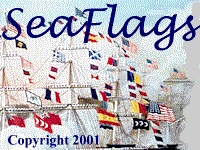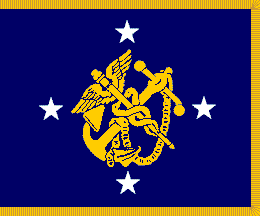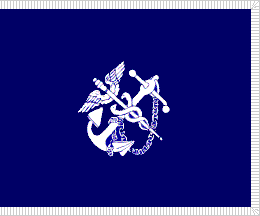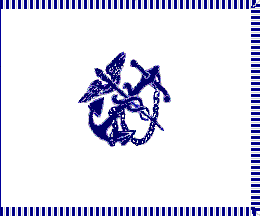 |
U.S. Public Health Service
|
On this page:
Return to Sea Flags home page
Public Health Service Flag
 The Public Health
Service, one of the seven uniformed services of the United States, dates
its history to the establishment of a series of marine hospitals for merchant
seamen in 1798. Although the marine hospitals were closed in the
early 1980s, the Public Health Service continues its status as a maritime
service, enforcing the nation's quarantine laws, inspecting passenger liners
to ensure their compliance with health regulations, and providing doctors
and other medical personnel to support the Coast Guard and NOAA Corps.
Since at least 1912, the Public Health Service has used a yellow flag with
the service seal--a crossed fouled anchor and winged caduceus--on the center in
blue. The badge was designed by the first supervising surgeon of
the Marine Hospital Service. The caduceus is not, as is commonly believed,
the traditional symbol
of medicine. That would be the staff of Aesculapius, with no wings
and a single serpent. The caduceus is rather the attribute of Mercury,
the Roman messenger of the gods, and therefore symbolizes the office of
the herald, in whose presence a truce was observed. As Mercury was
also the god of commerce, the caduceus also refers to the importance of
the Public Health Service's mission to the conduct of maritime trade. As for the
anchor, it not only represents the maritime nature of the service's original
mission, but also, in being fouled (having the chain wrapped around the stock and flukes),
indicates a mariner in distress. This may be the only instance in which the fouled
anchor--jokingly called the "seaman's disgrace" as a symbol of maritime services--is
actually a fully appropriate emblem and not merely decorative.
The current version of the flag has the emblem surrounded by the name of
the service and the date of its founding.
The Public Health
Service, one of the seven uniformed services of the United States, dates
its history to the establishment of a series of marine hospitals for merchant
seamen in 1798. Although the marine hospitals were closed in the
early 1980s, the Public Health Service continues its status as a maritime
service, enforcing the nation's quarantine laws, inspecting passenger liners
to ensure their compliance with health regulations, and providing doctors
and other medical personnel to support the Coast Guard and NOAA Corps.
Since at least 1912, the Public Health Service has used a yellow flag with
the service seal--a crossed fouled anchor and winged caduceus--on the center in
blue. The badge was designed by the first supervising surgeon of
the Marine Hospital Service. The caduceus is not, as is commonly believed,
the traditional symbol
of medicine. That would be the staff of Aesculapius, with no wings
and a single serpent. The caduceus is rather the attribute of Mercury,
the Roman messenger of the gods, and therefore symbolizes the office of
the herald, in whose presence a truce was observed. As Mercury was
also the god of commerce, the caduceus also refers to the importance of
the Public Health Service's mission to the conduct of maritime trade. As for the
anchor, it not only represents the maritime nature of the service's original
mission, but also, in being fouled (having the chain wrapped around the stock and flukes),
indicates a mariner in distress. This may be the only instance in which the fouled
anchor--jokingly called the "seaman's disgrace" as a symbol of maritime services--is
actually a fully appropriate emblem and not merely decorative.
The current version of the flag has the emblem surrounded by the name of
the service and the date of its founding.
The USPHS flag is produced in various proportions and sizes
depending on where it is to be displayed:
-
10:19 (the same proportions as the national ensign) for display from fixed
flagpoles at PHS facilities ashore.
-
2:3 for use on boats (as shown), in which case it is flown from the starboard
yardarm.
-
52 by 66 inches for indoor display, trimmed with a 2-inch blue fringe,
an eight-and-a-half foot blue cord and tassels, and the staff topped with
a brass spearhead finial of
the standard U.S. Army pattern.
Public Health Service flags are regulated by Personnel Instruction 1, "Public
Health Service Flags and Automobile Plates," in subchapter CC29.9 of the
Commissioned
Corps Personnel Manual.
Return to top of page
Assistant Secretary for Health
 This flag was adopted in 2008
to be used by the Assistant Secretary of Health and Human Services for Health when that
position is held by a commissioned officer of the Public Health Service. In such
situations, the assistant secretary holds the rank of a full admiral. The flag
is navy blue with the central device of the PHS seal in yellow, surrounded by four white stars
arranged as in the flag of an admiral in the Navy. For
indoor and ceremonial use, the Assistant Secretary's flag has a gold fringe,
cord, and tassels.
This flag was adopted in 2008
to be used by the Assistant Secretary of Health and Human Services for Health when that
position is held by a commissioned officer of the Public Health Service. In such
situations, the assistant secretary holds the rank of a full admiral. The flag
is navy blue with the central device of the PHS seal in yellow, surrounded by four white stars
arranged as in the flag of an admiral in the Navy. For
indoor and ceremonial use, the Assistant Secretary's flag has a gold fringe,
cord, and tassels.
Return to top of page
Surgeon General
 The Surgeon General
is the chief of the Public Health Service and by law holds a rank equal to that of the Surgeon General of the Army (currently a lieutenant
general). However, he or she is accorded four-star rank when concurrently appointed
as an assistant secretary of health and human services and is entitled to display
the flag shown above. Otherwise, the Surgeon General's flag
is blue with the central device of the PHS seal in white. It comes
in the same sizes as the PHS flag and displaces the service flag when the
Surgeon General officially visits a PHS installation or vessel. For
indoor and ceremonial use, the Surgeon General's flag has a white fringe,
cord, and tassels.
The Surgeon General
is the chief of the Public Health Service and by law holds a rank equal to that of the Surgeon General of the Army (currently a lieutenant
general). However, he or she is accorded four-star rank when concurrently appointed
as an assistant secretary of health and human services and is entitled to display
the flag shown above. Otherwise, the Surgeon General's flag
is blue with the central device of the PHS seal in white. It comes
in the same sizes as the PHS flag and displaces the service flag when the
Surgeon General officially visits a PHS installation or vessel. For
indoor and ceremonial use, the Surgeon General's flag has a white fringe,
cord, and tassels.
Return to top of page
Deputy Surgeon General and Assistant
Surgeon General
 The Deputy Surgeon
General and Assistant Surgeons General rank with rear admirals and rear
admirals (lower half). They use the same flag as the Surgeon General--and
according to the same procedures-- but with the colors reversed.
The only difference between the Deputy SG and Assistant SG flags is that
the fringe, cord, and tassels on ceremonial flags is intertwined blue and
white cord for the Deputy and solid blue for the Assistants.
The Deputy Surgeon
General and Assistant Surgeons General rank with rear admirals and rear
admirals (lower half). They use the same flag as the Surgeon General--and
according to the same procedures-- but with the colors reversed.
The only difference between the Deputy SG and Assistant SG flags is that
the fringe, cord, and tassels on ceremonial flags is intertwined blue and
white cord for the Deputy and solid blue for the Assistants.
Return to top of page
Return to Sea Flags home page
Sea
Flags
Copyright 2000, 2001 by Joseph McMillan


 This flag was adopted in 2008
to be used by the Assistant Secretary of Health and Human Services for Health when that
position is held by a commissioned officer of the Public Health Service. In such
situations, the assistant secretary holds the rank of a full admiral. The flag
is navy blue with the central device of the PHS seal in yellow, surrounded by four white stars
arranged as in the flag of an admiral in the Navy. For
indoor and ceremonial use, the Assistant Secretary's flag has a gold fringe,
cord, and tassels.
This flag was adopted in 2008
to be used by the Assistant Secretary of Health and Human Services for Health when that
position is held by a commissioned officer of the Public Health Service. In such
situations, the assistant secretary holds the rank of a full admiral. The flag
is navy blue with the central device of the PHS seal in yellow, surrounded by four white stars
arranged as in the flag of an admiral in the Navy. For
indoor and ceremonial use, the Assistant Secretary's flag has a gold fringe,
cord, and tassels.
The Surgeon General
is the chief of the Public Health Service and by law holds a rank equal to that of the Surgeon General of the Army (currently a lieutenant
general). However, he or she is accorded four-star rank when concurrently appointed
as an assistant secretary of health and human services and is entitled to display
the flag shown above. Otherwise, the Surgeon General's flag
is blue with the central device of the PHS seal in white. It comes
in the same sizes as the PHS flag and displaces the service flag when the
Surgeon General officially visits a PHS installation or vessel. For
indoor and ceremonial use, the Surgeon General's flag has a white fringe,
cord, and tassels.
The Deputy Surgeon
General and Assistant Surgeons General rank with rear admirals and rear
admirals (lower half). They use the same flag as the Surgeon General--and
according to the same procedures-- but with the colors reversed.
The only difference between the Deputy SG and Assistant SG flags is that
the fringe, cord, and tassels on ceremonial flags is intertwined blue and
white cord for the Deputy and solid blue for the Assistants.